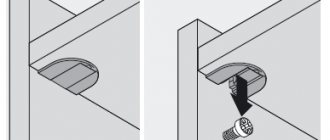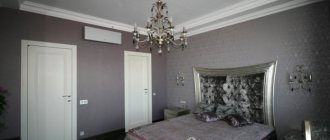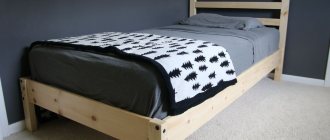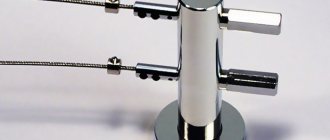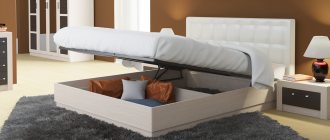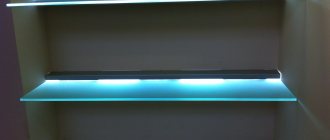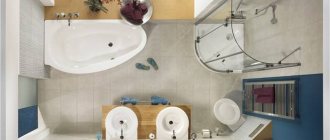How important is it
Placing electrical wiring is one of the most critical tasks when renovating a home. At the beginning of the process, it is recommended to decide where the equipment, computer desk, and TV will be located. This is the only way to install sockets at a convenient distance. When drawing up a source equipment diagram, it is also important to take into account the size of the room, the total number of sockets and switches.
Not only the ease of use, but also the appearance of the apartment depends on the location of the connectors. Incorrectly positioned devices can spoil the impression of a repair. A connector installed in the middle of the room will look awkward and will be inconvenient to use.
At what distance are they installed in the room?
Let's look at European and Soviet options for mounting connectors and find out the height from the floor.
European installation standard
This term became popular after the introduction of the definition of “European-quality renovation”. Some users find the following arrangement of sockets and switches convenient:
- switches at a distance of 90 cm from the floor surface (by passing by and without raising a hand, a person fixes the lighting in the room);
- mounting electrical sources at a height of 3 cm from the floor (at this distance you can hide the wires and conveniently use household appliances).
Soviet standards
Previously, sockets were fixed at a height of 90 cm from the floor, switches - at a distance of 160 cm. These indicators are no worse than the European standard and have a number of advantages:
- the plug can be inserted into the electrical socket without bending over;
- small children cannot reach the connector because it is installed at a height;
- This location is convenient for equipment that does not need to be constantly connected to the network (air conditioners).
Minimum height from floor
The rules for the installation of electrical installations and the design of residential buildings do not contain clear requirements for the location of sockets and switches with regard to floor coverings, walls and other elements.
The Electrical Installation Rules state that the distance from devices and gas pipelines must be higher than 50 cm. In the bathroom it can be placed at a distance of 60 cm from the sink.
At what height are plug sockets installed?
The joint venture states that electrical installations must be installed anywhere at a height of up to 1 meter.
The distance from sockets for connecting electric stoves and air conditioners is not indicated. In schools, kindergartens are placed at a height of 180 cm from the floor. The recommended length from the floor covering is 1 meter.
The height and distance are determined by the owner of the premises. In some cases the following rules apply:
- sockets are placed no closer than half a meter to the gas pipeline;
- in the kitchen and bathroom, electrical installations are placed at a distance above 60 cm from the floor surface and water supply.
After completing the installation of connectors for electrical devices and switches, the PUE indicates the need to carry out work regarding electrical measurements.
They will allow you to identify violations, possible problems and completely secure the process of use in everyday life. For proper and convenient placement of connectors and switches, it is first recommended to determine which way the door opens. Then the switches are placed on the side of the handles on the door leaves. This is done at a distance of 80 cm to 1 meter, depending on the height of the residents.
The placement of electrical installations depends on the type of room:
- in a long corridor, on the staircase, sources are installed at the beginning and end of the path;
- in the living room and bedroom it is comfortable when the switches are located at the entrance to the room and next to the sofa and bed to simplify the process of using lighting.
The length of electrical installations from the floor must be selected taking into account the location from which they will be accessible. For example, when entering a room, choose a height of 90 cm, next to an armchair or bed - 60 cm, so that it is convenient to reach with your hand.
Do-it-yourself wiring diagrams in an apartment
Electrics in the apartment: draw up a diagram and install it yourself
Electrical wiring in an apartment is the most important point from which any major renovation begins. The laid wires are most often located under a multi-layer “pie” of plaster and decorative finishing, and if all the nuances are not provided for in advance, problems with the network or the connection of a powerful device can lead to new repairs. Therefore, we will consider step by step how to do wiring in an apartment, but it’s up to you to do the work yourself or trust a professional electrician.
Making a diagram of the electrical wiring in the apartment
The main mistake of novice masters is incorrect planning of the upcoming work. When drawing up a network diagram, you cannot estimate the location of lamps and switches “by eye”; it is necessary to provide for every little detail so that the apartment does not have to be overgrown with tees and extension cords. Therefore, there is no way to do without drawings and calculations.
Do-it-yourself electrical wiring in an apartment: step-by-step instructions for drawing up a diagram:
1. Draw a general plan of the apartment, mark the location of windows and doors.
2. We schematically arrange furniture, plumbing fixtures and household appliances. Don’t forget about large accessories so that a mirror or picture does not end up in the place of the planned socket or switch. For greater clarity, electricity consumers can be highlighted in red. For example, like this.
3. We simplify the drawing: we remove furniture and other items that do not need to be connected to the network, and at the location of electrical appliances we mark sockets (single, double - it all depends on the number of consumers).
4. For convenience, we recommend thinking over a schematic designation for all network elements or using a hint.
5. As a result, we received the power part of the electrical circuit in the apartment.
6. Now let's start arranging the lighting fixtures. Typically, chandeliers are placed in the center of the room. To determine the location of the wires for them, you need to measure and halve the length and width of the room and mark the intersection of lines from these points on the diagram. In rooms with irregular geometry (L or U-shaped), you need to divide the room into 2 or 3 parts and find the center in each section. If additional lighting is provided with a network connection without the use of sockets, mark these devices on the diagram as well.
7. It remains to think about the location of the switches. It is clear that they will be located at the entrance to the room or near the zone lighting devices; the main thing here is to take into account which way the door will open, so that turning on the light does not turn into a game of touch in complete darkness. Switches are conveniently located on the inner wall of the room (with the exception of the bathroom and toilet).
The result of the preparatory work will be a general drawing, which will combine the plan of the power line, the layout of switches and lighting fixtures.
By the way, if you are not familiar with drawing, but you are familiar with a computer, you can make all the calculations and planning in special programs, for example “Electrician”, “DIA”, “sPlan”, “AutoCAD”, “Visio”.
Norms and standards that need to be taken into account when laying wires
According to modern standards, power distribution must include at least 2 autonomous lines - lighting and power (socket). Moreover, no more than 5 devices can be connected to one lighting line, and a maximum of 4 devices can be connected to a socket line (for powerful consumers such as a microwave, electric stove or washing machine, it is recommended to allocate an additional wire).
When drawing up a wiring diagram in an apartment, do not forget about the standards:
The cable must run from the ceiling, window, door openings and corners with a distance of at least 10 cm, and from the floor - at least 15 cm.
Wires should be laid horizontally and vertically at right angles to each other, keeping the lines parallel. Avoid all kinds of interweaving and intersections (the gap between the wires is from 3 mm). Also, you should not save money by laying the wire diagonally - the likelihood of subsequently forgetting its exact location and violating the integrity of the wiring with a banal nail is too high.
The distance between heating communications and electrical wires must be more than 3 cm.
Switches and sockets are conveniently located at the same height. There are no specific standards requirements here, but switches are usually placed at arm's length, and sockets are about 30 cm from the floor (with the exception of high-hanging devices).
Wires to switches are routed from above, and to sockets from below.
In no case should the grounding contacts of sockets be connected to water or heating communications or the neutral wire - this is dangerous to life.
Ideally, there should be no sockets in the bathroom, but if you cannot do without them, take care of moisture protection.
To install electrical wiring in an apartment with your own hands, you need to decide on the type of wiring.
There are 3 most common schemes: 1. Using junction boxes - the most economical option. The panel with the meter and circuit breaker is located on the staircase, and from it the power cable runs into the apartment. In this case, do-it-yourself wiring in the apartment from the panel is carried out through distribution boxes located at the entrance to each room.
2. Boxless or “star” method - each electrical appliance has a dedicated wire (ideally, a circuit breaker), which is wired into the apartment electrical panel. This type of wiring is considered the safest, does not require the installation of distribution boxes and allows you to control every element of the electrical network. But in practice it is rare, since it significantly increases the cost of the project (a large panel and three times the number of wires are required than with a box connection).
3. “Loop” - an economical version of the “star” provides for the sequential connection of several electrical points to a common conductor, which is inserted either into a distribution box or directly into a panel.
The most commonly used are combined options, which are selected individually for each project, based on the layout and energy resources of the house. For example, for low-power devices you can use a “loop” type connection, and for those that require high energy consumption, you can use a “star”.
To make it easier to determine the type of connection, it is recommended to group all electrical appliances by power, specifics of operation (lighting/power supply) and installation location.
For example, you can separate into separate lines: 1) lighting of living rooms; 2) lighting of the kitchen and corridor; 3) power supply to the kitchen and hallway; 4) electric stove, boiler and other powerful appliances; 5) power supply to living rooms; 6) power supply and lighting of the bathroom.
This will help avoid network overload and complete blackout of the entire room if partial electrical repairs in the apartment are required. For safety, it is necessary to install RCDs - residual current switches (and ideally, all lines should be provided with them) on the lighting and power supply group of bathrooms and kitchens. The result should be approximately the following diagram of the electrical wiring in the apartment.
Selection of wires and accessories
If you decide to do the electrical work in your apartment yourself, pay attention to the brand of wire and its cross-section. For sockets you will need a wire of 2.5-4 mm, and for switches - 1.5 mm.
The two types most in demand today are: 1) VVG - cable with copper conductors, each of which is protected by separate polyvinyl chloride insulation.
Pros: a variety of shapes (can be flat, triangular, round, sector, square), there is a fire-resistant modification (VVGng). Cons: high price.
2) PUNP (PUGNP, APUNP) – wires with insulated copper cores enclosed in a PVC sheath.
Pros: affordable cost Cons: materials can fail when heated, and the shape of the wire is only flat.
But wires with aluminum cores (APV, APPV, APRTO) should not be used when arranging home electrical wiring - they quickly fail from moisture and over time lose strength, which causes short circuits.
In addition to wires, you will also need the following accessories: • Sockets and switches (the best option is a hidden type). • Terminal blocks. • Distribution boxes with fire protection. • Automatic machines with RCD (10A or 16A is suitable for a lighting line, 25A or 32A for power supply, 40A for an electric stove).
How to do wiring in an apartment with your own hands
To know how to properly wire an apartment, you need to consider the following points: • Arrangement of floors and ceilings - suspended or tensioned structures, floor niches and ducts can be an excellent camouflage for part of the communications, allowing you to save on the length of wires and time for laying grooves.
• Wall finishing (thickness of plaster layer or leveling with plasterboard).
• Location of slabs – in panel houses you can use voids in the floors. True, the condition of the channels in them may be deplorable - they will have to be cleaned.
• Load-bearing walls - it is prohibited to violate their integrity. Yes, and concrete floors, especially in areas above door and window openings, are problematic, and then there is a risk of getting into the wiring when installing cornices.
Depending on these nuances, work can be performed in a hidden, open or combined way. Concealed installation is carried out in new buildings or during a major renovation of an apartment, because it involves gating the walls, followed by plastering and leveling them.
The algorithm for doing electrical work in an apartment with your own hands looks like this: 1. On the compiled electrical wiring diagram, the route for laying the grooves is laid out.
2. Using a marking cord, a plumb line and a building level, markings are made.
3. According to the markings, grooves are made using a hammer drill, grinder or chisel with a hammer. The standard width and depth of the recess for wires is 2 cm.
4. Wires are laid in the grooves, fixed to the wall with special dowel clamps or alabaster at intervals of 25-30 cm.
5. Socket boxes and boxes are installed, sockets and switches are connected.
6. The input panel is assembled: the lines are equipped with RCDs, and circuit breakers are connected.
7. At the final stage, it is recommended to “test” the electrical wiring in the apartment with a multimeter. If no problems arise, you can turn on the machine and test the assembled network.
Electrical wiring can be done in an open way by hiding the wires in corrugated pipes or closing them in special cable channels. This method is considered the simplest in terms of labor costs, but the most difficult in planning - after all, hiding or beautifully decorating camouflage structures is quite problematic. Therefore, most often, do-it-yourself wiring in an apartment is done using a combined method.
And the last piece of advice: after finishing the electrical wiring in the apartment, be sure to save its diagram in the archive with documents - it will come in handy more than once during renovations and beyond.
You may be interested in: Decorating walls in an apartment with your own hands: updating the interior without major renovations Wall decoration is designed to perform two functions: protective - to protect from deformation and contamination, and decorative - to decorate the room, helping to create an exclusive one. How to install a false fireplace in an apartment with your own hands A fireplace is one of the most beautiful, romantic and difficult interior elements to arrange (especially when it comes to a city apartment). That's why. Do-it-yourself arch in an apartment With the beginning of the era of European-quality renovations, homeowners took a different look at their home. Everyone is pretty tired of the dark corridors with many closed doors, like in... How to install lamps with your own hands The ceilings are painted, the walls are papered - this means that the renovation is nearing the finish line, and you can start installing the lamps. And here on this one. Do-it-yourself Roman blinds Roman blinds, also called Latin or Roman blinds, were invented by sailors who sewed them according to the principle of attaching ship sails. These curtains. How to install electrical wiring in an apartment?
Installing electrical wiring in an apartment with your own hands is not as time-consuming and expensive as installing wiring in a house. This is due to the fact that there is no need to draw a line inside the housing, because this is provided by the developer company.
Cable distribution to rooms consists of the following steps:
- drawing up a diagram;
calculation of the amount of necessary materials and electrical fittings;
It should be noted that today open wiring in an apartment is no longer used, so in this article we will consider installation work in a hidden way.
You can view all cables suitable for such wiring on the website https://cable.ru/cable/kabel-dom.php Detailed technical characteristics of each brand are indicated there. Next, we will provide detailed step-by-step instructions from scratch, which is suitable for beginners who want to test their electrical skills.
Drawing up a diagram
It’s easy to make a wiring diagram in an apartment with your own hands. To do this, it is recommended to use a photocopy of the new building plan, on which you can conveniently mark the installation locations of sockets. switches, lamps and other components.
The starting point of the diagram is the location of the distribution panel in the apartment. Usually this place is the corridor, next to the front door, at a height of approximately 1.5 meters from the floor.
When compiling, we recommend that you consider the following tips and rules:
Height of sockets in kitchen and bathroom
The bathroom is a rather problematic place, since it has a high level of humidity and a high risk of water entering electrical installations. To install power supplies for household appliances, you need to know where to place the devices correctly. The bathroom is divided into zones:
- Zone 0 is the most dangerous for moisture penetration. These are areas located next to the bathtub, shower stall, and sink. It is allowed to install 12 V sockets here. But this voltage is rarely supplied in private homes.
- Zone 1 allows the placement of water heaters.
- Zone 2 allows the installation of boilers, a fan, and a lamp. Power sources must be located at least 60 cm from the water.
They purchase special devices and switches that have high protection, allowing them to be used in wet rooms. Another prerequisite is the presence of grounding, a circuit breaker and an RCD with a leakage current of 10 mA.
Regarding the location of sockets in the kitchen, the SP and PUE are not written directly, so it is better to proceed from the basic requirements and take into account the characteristics of the room. What are the rules:
- sockets and switches should be located at a distance above 60 cm from the floor and water sources - sinks, water pipes;
- A gap of 50 cm must be maintained between the gas and the stove.
When it comes to electrical equipment in the kitchen, many difficulties arise: you need to take into account the location of communications, install separate lines for powerful appliances - a dishwasher, a washing machine, and install sockets in a convenient and practical place. A conditional standard for the location of electrical power in the kitchen has been formed. It divides the room into three levels:
- Lower - 15 cm from the floor, electrical installations are installed for those appliances that can be turned on for a long time - a dishwasher, a refrigerator. This location has 2 advantages: the cords do not get in the way and do not hang on the walls, and they can be easily reached.
- The second is at a distance of 100-130 cm from the floor covering. Switches and sockets are placed here for equipment standing on the tables - blender, toaster, microwave. The exact value depends on the location of the furniture in the kitchen.
- Third level. Connectors are mounted on it at a height of 2 to 2.6 meters. You will need a chair to access them. These sockets are designed to connect hoods and lamps that are built into cabinets. Electrical sources are not visible from the floor, since they are hidden behind shelves and furniture.
There are no established standards governing the location of sockets in rooms and general premises. There is only one limitation - mounting above 1 meter in height is unacceptable. Standards relating to bathroom wiring have also been adopted.
Location of sockets in the bathroom: features
Installation and location of sockets in the bathroom requires maximum attention and knowledge, and certain rules. This is due to the high humidity in the room and the presence of water.
Parameters for correct installation of sockets:
- Wiring quality;
- Correct selection of sockets;
- Electricity supply from a shield with protection.
First of all, before starting installation work on electrical wiring and power supplies for household appliances, it is necessary to correctly select all structural elements. The wiring must be well insulated and it is best if it is located hidden. Provided that it is not possible to install the wiring in a hidden way, it is necessary to ensure that the conductors are protected from moisture and condensation.
Sockets and switches that are installed directly in the bathroom must be protected from moisture and meet protection standards of at least IP – 65. These devices require the presence of protective rubber gaskets between the elements of the device.
Safety elements also include connecting conductors in the panel using a residual current device (RCD). This device instantly turns off the power supply after it detects small leaks (milliamps) of electric current.
In order to place sockets in the bathroom correctly, it is divided into 4 areas. The first area is in direct contact with water, the second involves the installation of water heaters, lighting fixtures can be placed in the third, and sockets are installed in the fourth area with the least likelihood of water getting in.
The installation height of the sockets depends on the length of the cables of the devices connected to the power supply.
To connect powerful appliances (for example, a washing machine), a separate socket is provided; to connect small-fashion electrical appliances (for example, a hair dryer), you can install a group of sockets using one platband. The installation height of sockets in the bathroom must be at least 0.6 m from the floor level.
Features of placing sockets in the bedroom
Did you like the article? Follow new ideas from the world of construction, design, and useful tips in our channel. Subscribe to us in Yandex.Zen. Subscribe.
The space of any room should be used 100% rationally, as conveniently and efficiently as possible. The placement of sockets for connecting electrical appliances is of great importance for this.
Standard electrical wiring is usually not enough. To avoid a large number of tees and extension cords, you have to install additional sockets
It is necessary to consider which electrical devices will be used simultaneously. So that extension cords do not interfere with cleaning, and you do not need to turn off the TV to recharge your phone, the location of sockets in the bedroom must be correct and the number must be sufficient.
Too much is better than too little. The presence of an unused outlet will not be noticeable, but the lack of even one will bring a lot of inconvenience.
The best option for placing an outlet above a bedside table
Based on the above, the best option is a convenient option. The main thing is that the product is comfortable to use.
Important! Don't forget about the length of the wires for your existing gadgets.
Calculate everything in advance: purpose of use, tasks, length of wires, possible rearrangement, and then proceed with installation. The ideal option is 10 cm above a standard height cabinet. Thus, the location of the outlet is 70 cm from the floor.
When planning renovations in an apartment/house, you need to pay special attention to the location of electrical accessories. It is advisable to sketch out a plan for the lighting scenario for each room, the layout of switches, and the connection of electrical appliances.
For example, sockets in the bedroom require connecting a sconce (night light), iron, TV, charging a tablet, or a phone. By thinking through everything in advance, you can ensure a comfortable, safe stay for your family in the room, eliminating the presence of extension cords, additional wires, possible damage and short circuits. How many sockets do you need? How to arrange them correctly? Let's answer this question step by step.
Functional areas in the bedroom
A place to sleep, that is, a bed or sofa, a dressing table, a closet and perhaps a small work space are the functional areas of the bedroom. Each of them must be equipped with one or more plug connectors.
Sockets must be above the desk if there is one in the bedroom
If the apartment is small and additional zoning is needed, in which the room is divided into bedroom and living room areas, more plug connectors will be required.
Socket by the bedside table
How to properly place sockets above the bedside table in the bedroom? Typically this room has a bedside lighting source - a floor lamp or table lamp. Also, the sleeping area requires a power point to recharge mobile devices.
To charge a phone or work with a laptop, a modern person cannot do without an outlet near the bed. It's better if there are several of them
To recharge gadgets, you can install USB sockets, which are available with one or more connectors and combined with an input for a regular plug.
Based on such data, the number of outlets in this location should be determined.
A socket with a USB socket will solve the eternal problem of finding a charger
It is advisable to place sockets above the bedside table in the bedroom at a height of approximately 70 cm from the floor, since the standard height of a bedside table is 55-60 cm.
At the doorway
A power point near the door is required to turn on the vacuum cleaner. According to European standards, it should be 30 cm from the floor so that water and detergents do not get into it during cleaning, and the cord of an electrical appliance does not hang down the wall.
It would be a good idea to provide an outlet for a vacuum cleaner next to the switch located at the door of the bedroom.
For other electrical appliances
However, there are no official standards for the height of placement of electrical elements; they can be placed higher by combining an overhead light switch and several sockets for connecting a vacuum cleaner, iron or fan in one unit.
Sockets for fans and other household appliances should be located in convenient places where electrical devices will not be obscured by furniture
The entrance for the air conditioner is made under the ceiling, and the sockets for the television system are hidden behind it, since these devices do not require frequent shutdown.
The TV area needs several sockets. Minimum – 2 electrical outlets and antenna cable socket
Installation of sockets and switches according to European standards (video)
Using this information, you can easily choose the quantity and quality of sockets and switches. Otherwise, it all depends on your preferences.
Comments
0 Misha 02/18/2018 21:01 First of all, you need to focus on the furniture; sockets should be located so that they are comfortable to use.
You should not always be guided only by GOST standards. Quote
0 Valya 01/29/2018 06:17 In our house, all the sockets are located at a height of about 1 meter above the floor. I think this location is optimal. Friends have them installed much lower, about 30 cm above the floor. Convenient, but dangerous.
Quote
0 Peter 01/28/2018 06:31 20 cm from the floor - this means that you have to bend over each time to insert/pull out the plug. Obviously inconvenient. Well, I also realized that you can’t have too many sockets at home. In a small room I installed 4 groups of 4 sockets each and still there are not enough of them for some devices. Well, of course, the wire cross-section is 2.5 for simple ones.
Quote
0 Vladislav 01/23/2018 06:22 I quote Valentin:
I struggled with this issue for a long time, and eventually placed all the sockets in the house at a height of 20 cm from the floor. Now I don’t regret it, it’s very convenient and doesn’t catch the eye. The only negative is small children, but this too is all thought out. Special plastic plugs are sold.
Plugs, of course, are a good thing, but they provide protection when children are very small and cannot remove them.
My little boys have learned to use a fork to pry it on and off, and now I regret that the sockets are located too low. Quote 0 Lera 12/13/2017 21:03 You also need to focus on furniture and appliances, otherwise it will turn out that the outlet will be behind the closet or at the table. Functionality is very important, I would put it in the very first place.
Quote
0 Daniil 12/06/2017 06:21 I didn’t know that there were any rules regarding height. For me, the main thing is to place sockets away from water and fire if in the kitchen, but otherwise you can install them anywhere as long as it is safe.
Quote
0 Valentin 12/04/2017 06:54 I was tormented by this issue for a long time, and in the end I placed all the sockets in the house at a height of 20 cm from the floor. Now I don’t regret it, it’s very convenient and doesn’t catch the eye. The only negative is small children, but this too is all thought out. Special plastic plugs are sold.
Quote
Update list of comments RSS feed of comments for this entry
Electrical distribution in the apartment. Rules for the height of sockets in the bedroom
Electrical distribution should be planned at the renovation stage, having previously determined what the arrangement of furniture and household appliances will be in the apartment. Then the wires can be laid inside the walls, and the terminals for switches and sockets can be made in the most suitable places.
Laying hidden wiring is a dusty and dirty business, so the work should be done at the initial stage of repair
Optimal electrical circuit for the bedroom
There is no universal electrical wiring diagram for a bedroom. Its correct option should be developed for each specific case, taking into account the location of the bed, dressing table, wardrobe, TV and air conditioner.
The optimal electrical circuit for the bedroom, thought out in advance and agreed upon with its potential inhabitants, will make the use of electrical appliances rational and comfortable.
It is recommended to place pass-through switches for the main lighting near the door and near the sleeping places, so that when entering the room you can turn on the light and turn it off without getting out of bed.
Layout of sockets in a bedroom for two
For local illumination of the dressing table, a switch is provided in the case of using sconces mounted in the wall on both sides of the mirror. If the lighting source is table lamps, they need two sockets hidden behind the table.
How many sockets are needed?
The number of sockets in a sleeping area depends on the number of people who will live here, their interests, the size of the room, and the location of the furniture. If the room is for one person, then there may be a quarter less of them compared to a double room.
To have an idea of the minimum comfortable number and location of power supply points, you need to know where they should be installed.
So, most often the connector is needed:
- In the bedside area, where bedside tables with night lamps are usually placed. This is very convenient for a family with a small child or for those who like to read a magazine, newspaper or book. Moreover, an outlet must be installed near each bed.
- For TV and related equipment. For this purpose, at least two sockets are installed.
- For connecting an iron.
- Near the front door for a vacuum cleaner and other electrical appliances.
- Near the desk/dressing table. Here it is better to place several sockets for electrical power supply to a table lamp, computer and related equipment.
Let's sum it up, we get 8 electrical power sources. We emphasize: this is the minimum required amount that should be needed to decorate a modern bedroom.
Socket by the bedside table
How many sockets for connecting electrical appliances should be located near the bed? It all depends on the habits, lifestyle and needs of the owners of the room. Some people like to read literature in the light of a lamp or prefer to turn on a laptop/tablet to check email, surf social networks, or play online games.
So, bedside sockets are needed to connect:
- small lamps - night lights, sconces, bedside table lamps;
- charger for all kinds of gadgets: phones, laptops, tablets;
- additional technical devices: electronic alarm clock, salt lamp, receiver, heating pad, etc.
Sockets by the bed are located at arm's length from the sleeping place, usually above the bedside table at a height of 10–20 cm.
Attention! Three sockets are the optimal number for one bed. If there is a double bed, their number doubles.
TV sockets
Many people prefer to turn on the TV before going to bed to watch the news, a movie, or a program. Moreover, the TV is often used as a monitor that receives signals from a digital or satellite television tuner, DVD recorder or player, VCR (if there is one) and other video equipment. To power them, an additional source is needed, but a “block” of several outlets is better.
General purpose sockets
The location of electrical installation products near the front door or window sill is not always provided for by designers, but their presence is necessary for connection:
- heaters: UFO, Termoplaza, ceramic or oil heater;
- vacuum cleaner;
- decorative fountain;
- air conditioner;
- humidifier, etc.
If the bedroom is large, then it is advisable to install two blocks of sockets on opposite walls of the room.
Iron socket
If the house/apartment does not have a dressing room, laundry room or linen room, then you have to iron the laundry in the bedroom. The iron is a powerful consumer of electricity, therefore, to connect it, regardless of the size of the sleeping area, a separate connector must be provided. It is installed at a distance of 10–15 cm from the ironing surface. Otherwise, using the iron will not be so convenient.
Socket at the dressing table
The area of the room near the dressing table is any woman’s favorite place. Usually there is a mirror with built-in or table lighting (and more than one), a hair dryer, curling iron and other items that help highlight female beauty.
To ensure the operation of electrical devices, a block of 3–4 sockets is provided, rising 5–10 centimeters above the level of the countertop.
Height of sockets in the bedroom
Two factors that are taken into account when choosing the height of placement of sockets and switches:
- convenience;
- harmonious combination with the interior of the room.
Advice! When calculating the height of switches/sockets, consider the height of the finished floor.
In the bedroom, all power points should be visible, easily accessible for regular use, and not installed according to the “European standard” - at an interval of 30 centimeters to the floor or according to the “Soviet” - at an interval of 90 centimeters above the floor surface.
Attention! It is strictly forbidden to place sockets less than 30 cm from the floor! The ingress of dust, debris, and water during cleaning can result in a short circuit, electrical wiring failure, or even a fire.
Practical and standardized recommendations:
- place the connectors at a distance of 25 cm to the sleeping place and at a distance of 60 cm to the floor or 10–15 centimeters to the surface of the tabletop of the bedside table;
- separate bedside connectors by placing them at a distance from each other and/or at different heights;
- install power supplies for electrical appliances on an open wall (without installed furniture) at a height of 50–100 centimeters;
- install sockets near the cabinet to install lighting in it.
It is important that sockets and switches are of high quality and fit harmoniously into the interior of the room. Therefore, it is recommended to buy only those electrical installation products that are made according to European standards.
Rules for placing switches in the bedroom
The same principle applies to the placement of switches; in the bedroom it is advisable to use their walk-through modifications, with the help of which you can turn off any light source while being in the area of the bed or at the exit.
A pass-through switch allows you to turn off the central light without getting out of bed
Advice from electricians and designers about the location of sockets in the bedroom: Electricians advise not to skimp on purchases and to purchase high-quality products from well-known manufacturers.
Useful tips
Sockets are not only a necessary technical design, but also an attribute that can become an excellent addition to the interior. Manufacturers produce a wide range of designs with bodies of different decorative shapes and colors. There are built-in sockets, as well as products equipped with special covers that mask the hole. Thanks to such an assortment, choosing the right option is not so difficult.
Due to heavy loads, the wiring in the bedroom must be replaced during the construction phase. Otherwise, there is a possibility that if there is an overload, the entire network will fail. When installing a new cable, it is recommended to give preference to copper wires or modern material made from a mixture of aluminum and brass.
If you have no experience in performing construction work, it is better to trust the professionals. When choosing the location of electrical appliances, you can rely on domestic and European standards. Electricians prefer the latter because they combine convenience, practicality and safety.
Electricity today is the main source of energy for almost all household appliances. To optimize the operation of such devices, it is important to choose the correct location of outlets in the bedroom. They are tailored to the specific needs of a person, including his dimensions and technical characteristics of the equipment. The modern market involves many modifications of these items. Therefore, when purchasing, it is important to pay attention not only to the design, but also to the technical characteristics of the sockets.
Experts recommend using products only from well-known and trusted companies.
Design of sockets in the bedroom
Typically, they try to position sockets so as to make them invisible. But still some of them remain in sight. They can be turned into a real interior decoration.
Interesting design solutions
Products of various styles and types are now on sale:
- Stylized as wood, stone, ivory.
- Made in the form of various figures, for example a hand showing OK.
- Multi-colored, illuminated or glow in the dark.
- Convex and flush with the wall surface.
- Even modern devices are produced, stylized as ebonite black sockets of the first half of the last century.
What you need to know about the location of outlets
So, in order to correctly position sockets in the bedroom, you need to remember a few rules.
Powerful electrical appliances, such as an iron or a mobile air conditioner, must be provided with a personal power point
Practice tips
Practical experience shows that:
- It is better to plan the layout of sockets and switches at the renovation stage.
- When calculating their number, it is better to err on the larger side.
- It is necessary to take into account the location of furniture and household appliances.
- Consumables must be of high quality.
- Child protection required.
- Visible electrical elements may be decorative.
Properly located sockets and switches should provide comfort to the occupants of the home.
Design solutions
Classic models of sockets are available in white, which harmonizes with almost any type of interior. To beautifully fit products into the design, you should use only built-in modifications. It is also important to pay attention to the style of switches, which are very often mounted near sockets.
If the bedroom interior was created by a designer, it can be complemented by retro designs that are characterized by a corresponding appearance. They can also be supplemented with appropriate wiring and switches.
Selecting and installing sockets is an important task that should only be undertaken by experienced professionals. This will not only speed up installation, but will also provide the bedroom with the optimal number of power sources.
To learn how to properly position an outlet in the bedroom, watch the following video.
Modern man is completely dependent on electrical energy. This is due to the fact that he uses a lot of household devices, the functionality of which is ensured by this energy source. It is necessary to choose the right location of sockets in the bedroom, since a person spends a lot of time here.
